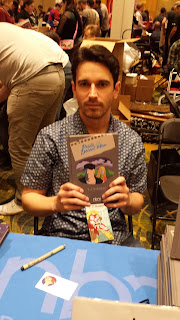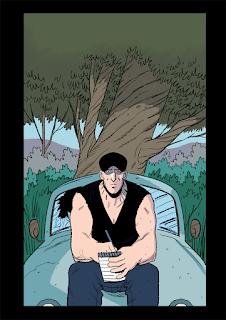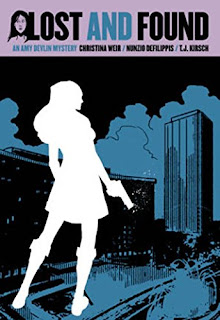 by Mike Rhode
by Mike Rhode DC Zinefest 2018 recently had a successful day out at Art Enables on Rhode Island Ave. I met at least six cartoonists who were new to me, and said hi to at least three I already know. (My photos are here). Rachelle Holloway, an illustrator and cartoonist, is the first to answer our usual questions.
What type of comic work or cartooning do you do?
I am currently a freelance illustrator for Mascot Books. I work on children's books and draw my own webcomic, A Little Dragon Trouble, on the side. When it comes to my own personal work, I love drawing fantasy and artwork with a Scandinavian feel to it.
How do you do it? Traditional pen and ink, computer or a combination?
Most of my work is done using the computer. But I also enjoy using traditional pen and ink. Sometimes I get tired staring at the computer screen, so drawing traditionally can be relaxing. I love painting with gouache and watercolor, and I also enjoy cut paper art.
Where did you grow up?
I grew up on the West Coast, mainly in San Diego, California and Washington State. That's where I call home.

What is your training and/or education in cartooning?
In 2014, I graduated from Savannah College of Art and Design with a B.F.A in Animation. I mainly focused on 2D animation, but my primary focus and interest was Concept Art and Visual Development. I took one Sequential Art class while I was in college, but when it comes to comics, I am mostly self taught.
Who are your influences?
I have so many influences that I can't list them all. I find inspiration from everywhere and everyone! Here is a small list of people who influence my work: John Howe; John Bauer; Lorelay Bove; Brittney Lee
If you could, what in your career would you do-over or change?
If I were granted a do-over, I may have studied Illustration or Graphic Design. I don't regret studying animation, in fact, it has helped me with the creative work I’m currently doing. But on the East Coast, I have discovered a lot of skills people are looking for in the creative industry are Typography, Web and Graphic design. But that hasn’t stopped me from pursuing that education. I just finished a Web Design class at Northern Virginia Community College, and am learning new skills to better myself as a creative professional.
What work are you best-known for?
I feel I am not really best-known for anything in particular yet. My Zine, My Dog is More Paranoid Than I Am, is my most popular comic. I'm also known for having a lot of Scandinavian/Viking artwork, which gets people’s attention.
What work are you most proud of?
I am personally most proud of my webcomic, A Little Dragon Trouble. For my Senior Film In college, I wasn't able to fully do what I wanted to do. So a few years later, I developed A Little Dragon Trouble. My webcomic has also helped me in so many other ways. It has helped me gain an audience. The visual development of the comic was recognized on Behance and featured on Small Press Expo's tumblr blog. It is because of this comic I am where I am today.
What would you like to do or work on in the future?
I would like to self publish my own picture book. After illustrating a kids book for an author, I was inspired to create a short story myself. I would love to have the time to illustrate and self-publish it. I also have many comic and story ideas written down, and would like to make them a reality.
What do you do when you're in a rut or have writer's block?
When I'm having writer’s block, I write down situations or events I don't want happening in my story. Sometimes it ends up being a good idea anyway. Another approach is don't think, just write! Even if you know it's bad. You can always go back and change it later.
What do you think will be the future of your field?
I definitely see myself continuing being an illustrator and getting more requests from authors. But, I hope one day to be employed in the animation industry. But in the meantime, freelance illustration is what's keeping me going!
 What local cons do you attend besides DC Zinefest? The Small Press Expo, Intervention, or others? Any comments about attending them?
What local cons do you attend besides DC Zinefest? The Small Press Expo, Intervention, or others? Any comments about attending them?I just started tabling for the first time in 2017. DC Zinefest was the first event I tabled at. I also tabled at Richmond Zinefest last year. I would love to attend larger cons such as Small Press Expo, but I want to have more work under my belt before I do that. It is a goal I am striving for.
What's your favorite thing about DC?
I'm originally from the West Coast, so finding things to love about DC was a challenge when I first arrived. In 2016, I found out that DC has an amazingly open and welcoming sequential art culture. Everyone's work is so Indie and original, I love it! They are willing to express themselves and everyone supports each other. It's because of that culture I felt comfortable enough to start displaying my own work. DC has helped me grow as an artist, even though the artist culture is small. But that's what makes it so great!
How about a favorite local restaurant?
There's this wonderful place called the JINYA Ramen Bar in Fairfax, VA. I like to go there to celebrate the completion of large projects.
Do you have a website or blog?
http://rahcomics.tumblr.com/
https://www.instagram.com/rahcomics/
http://rachelleholloway.blogspot.com/
 |
| "A traditional ink trading card I sold at last years Richmond Zinefest." |























